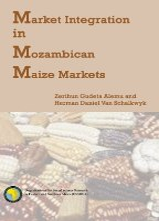Women In Agriculture & Rural Livelihoods
Women, Coffee and Climate
Modern Day Slavery
P/CVE Project
Migrating out of Poverty - Ethiopia
ELLA Project

Maize is the staple food and principal cash crop in Mozambique. Maize production is dominated by smallholders who sell their surpluses to generate income. Interregional maize trade is very important in Mozambique because the south is a maize deficit region in all years and the north is a maize surplus region, even during regional droughts. Trade between these two regions has implications for food security in the south of the country, as it can result in increased food security and income distribution to the rural poor. An integrated market system can therefore be expected to accelerate the economic development of the country.
For the past two decades, policy and institutional frameworks in Mozambique have gone through dramatic changes as the country moved from a Government that was highly centralised to a Government that is de-centralised with an open, market oriented economy. Maize markets have been consequently affected by these changes that maize markets have been liberalized since 1987 following the introduction of Economic and Social Rehabilitation Programme (ESRP). The major elements of the ESRP are now in place; particularly regarding maize marketing, where the Government plays no role. It is expected that these changes will contribute to improvements in the performance of maize markets. Several years after the implementation of the free market system, it is of great importance to asses the extent to which it has led to higher levels of market integration.
This research attempts to measure the extent of market integration between major maize markets in Mozambique. This study was motivated by the fact that the maize industry is an extremely important sector of Mozambique’s agrarian economy, and a source of food and income for the population. Therefore, the impact of market reforms on the marketing performance of the maize industry should be of particular concern to the Mozambican Government. In order to efficiently manage reforms in the maize industry, policy makers need to understand the functioning of markets, price integration between markets, and how these factors relate to changes in the institutional and policy environment of markets. This understanding will allow them to design effective market policies, institutions, and the marketing infrastructure required for the development of maize markets.
The report begins by tracing the historical path of policy making in Mozambique from 1975 to 1987 (the socialist era), when the Government controlled and regulated maize markets; and since 1987, when the economic reforms which included market liberalisation supported by the Bretton-Wood institutions under the Economic and Social Rehabilitation Programme (ESRP) were adopted. The report further shows how maize markets were affected by policies adopted during the two periods.
Two interrelated methods were then used to measure the extent of market integration. Firstly, a market survey was carried out in major consumption markets in Mozambique, to investigate the dynamics and operations of the informal marketing system in the country; and secondly, econometric analyses using monthly white maize prices per kilogram at retail level from 1993 to 2004 were carried out to determine the level of market integration in Mozambican maize markets.
The econometric procedures were preceded by a preliminary analysis using simple descriptive indicators such as price level, price spreads, price levels and spread variability, and price correlation coefficients. A more robust Threshold Vector Error Correction Model (TVECM) was then applied to measure the extent of market integration between major maize markets. The choice of the model was motivated by unobservable transaction costs and the important influence that their presence may exert on equilibrium spatial price relationships. Unlike other models that account for transaction costs, TVECM does not require actual data on transaction costs, which is seldom available. Instead, TVECM attempts to determine a threshold (measure of transaction costs) from the price data.
The market survey revealed that informal maize traders in Mozambique view high transportation costs, lack of working capital and poor roads as the major constraints to maize trade. Grain businesses in Mozambique generally operate on small scale, with rapid turnover of product and little storage beyond three days to one week.
The preliminary analysis using simple descriptive indicators, such as price level, price spreads, price levels and spread variability, and price correlation coefficients (the magnitude and the level of statistical significance) indicate that the interaction of maize markets in Mozambique has improved after the 1987 reforms.
The results from the TVCEM indicate that the integration of maize markets in Mozambique improved after the 1987 reforms were instituted. Significant dynamic relationships exist among price series studied for different market pairs. The results also indicate that threshold values (i.e. estimates of transaction costs) are positively correlated with the condition of the roads connecting markets. Persistent deviation from equilibrium was found in one out of three market pairs. It takes about four to eleven months for positive and negative shocks introduced in deficit and surplus markets to be redressed. The results further reveal that three out of four market pairs analyzed for this study were integrated. The paper concludes that maize markets in Mozambique are integrated.

